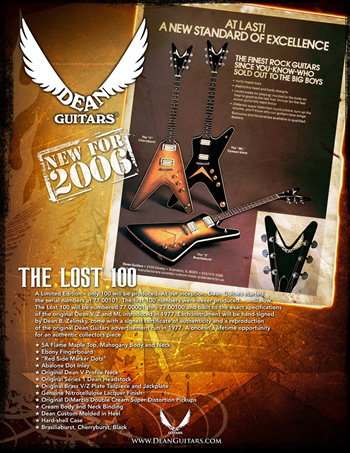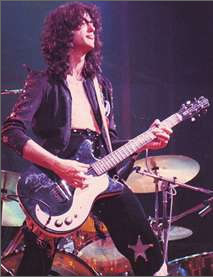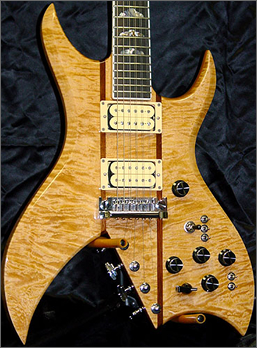 The Bich was launched in 1977 alongside the Seagull and Mockingbird in the BC Rich range of the 1970s. It featured the most daring of BC Rich’s “vintage†designs, with a body originally penned by renowned luthier Neal Moser.
The Bich was launched in 1977 alongside the Seagull and Mockingbird in the BC Rich range of the 1970s. It featured the most daring of BC Rich’s “vintage†designs, with a body originally penned by renowned luthier Neal Moser.
It featured two very unusual cutaways on the bottom of the body, a neck-through design, and originally was only available as a ten-string model (see photo), which had 4 tuning pegs at the bridge end for the 4 extra top strings.
However, this limited the appeal of the guitar somewhat, and so a normal six string was launched soon after. It featured all the usual other trimmings on 1970s BC Riches, including elaborate coil-splitting functions and a dizzying array of switches and knobs..
Master Volume, Rhythm Pickup Volume, Pre-amp #1 Volume, Pre-amp #1 On/Off, Pre-amp #2 Volume, Pre-amp #2 On/Off, Phase Switch, Pickup Selector, Six Position Varitone, Dual Sound Rhythm Pickup, Dual Sound Lead Pickup and Master Tone.
When all switches are off the guitar is in passive mode. At this time both pickups are controlled by the master volume. Both pick-ups are activated by pick up selector switch. The tonalities of both pickups in passive mode are controlled by the Master Tone.
Click on the preamp On/Off switch and get an instant 10 db boost from the gate. At this point the pick-ups are now controlled by the pick-up volume control while the master tone still controls the tonality of both pick-ups. With both pick-ups on, phase switch in the up position will produce an out of phase sound, (a tone resembling a half cocked wah sound).
To coil tap the lead pickup flick upward dual sound switch. This converts the pick-up into a single coil sound by separating the pick-up into one coil. Dual sound switch #6 performs the same task for the rhythm pick-up.
As you rotate the six-position varitone clockwise, each position produces a distinct sound based on whichever capacitor is in operation. You will also notice a slight decrease in gain but the pre amp volume can compensate the drop and then some. It is only as limited as your imagination.
All these switches can be use to your liking & when you find a particular sound you like, make note of the setting for future reference. The B.C. Rich Active Electronics produces a spectrum of 154 distinct sounds. If you really want to get really funky with all switches on as described rotate master tone counter clockwise. If you are a traditional blues player you will find sounds you never knew existed. Note that all pickups function while in passive as well as active mode. The battery can easily be changed by carefully removing the screws for the control cavity plate.
The main difference between the active and full active electronics system is that the full electronics system has two independent preamps as well as two volume switches which can work in unison or individually and can naturally distort the volume even at low settings.
The B.C. Rich Active and Full Active systems offer more sounds than any other onboard electronics.
The Bich is still available and is a very popular model in BC Rich’s line. It is available as a ten string, six string, bolt-on and through-neck versions, with prices starting from around £250. However, like other older BC Riches, the 1970s versions command upwards of £1000 when on sale.

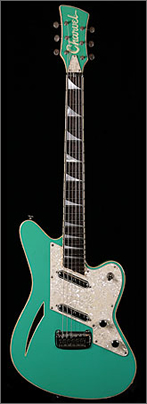 The Charvel company, which spawned the famous and reputable brand Jackson Guitars, is also well known for their very high-quality superstrat models and for a while was the chief supplier of Eddie Van Halen’s guitars. In 1992 Charvel launched their biggest break from their usual superstrat tradition (the company also dabbles in Telecaster-shaped models and four-pointed star-shaped models).
The Charvel company, which spawned the famous and reputable brand Jackson Guitars, is also well known for their very high-quality superstrat models and for a while was the chief supplier of Eddie Van Halen’s guitars. In 1992 Charvel launched their biggest break from their usual superstrat tradition (the company also dabbles in Telecaster-shaped models and four-pointed star-shaped models).
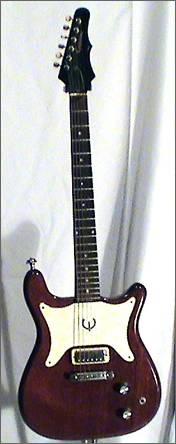 The Epiphone Coronet was launched in 1958 as an alternative to the popular Gibson Les Paul Junior. It was part of a range of models made from the late 50s to 1970. The range included the Crestwood, Coronet
The Epiphone Coronet was launched in 1958 as an alternative to the popular Gibson Les Paul Junior. It was part of a range of models made from the late 50s to 1970. The range included the Crestwood, Coronet 
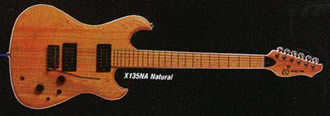 The Phoenix was the best known of Electra’s original models, a vaguely Strat-shaped guitar available as a series of 10-15 different models. The one featured on the site , I believe to be a Phoenix X135 model. This model featured an ash or maple body (the one for sale looks maple to me), and two coil-tapped humbucking pickups. This one is in a natural finish and is possibly an earlier model due to the inclusion of a scratchplate.
The Phoenix was the best known of Electra’s original models, a vaguely Strat-shaped guitar available as a series of 10-15 different models. The one featured on the site , I believe to be a Phoenix X135 model. This model featured an ash or maple body (the one for sale looks maple to me), and two coil-tapped humbucking pickups. This one is in a natural finish and is possibly an earlier model due to the inclusion of a scratchplate.
 I found this guitar for sale today while I was cruising around some guitar sites.
I found this guitar for sale today while I was cruising around some guitar sites.
 The original Mockingbirds had neck-through body design, as all BC Riches then had and many do in the current range.
The original Mockingbirds had neck-through body design, as all BC Riches then had and many do in the current range.
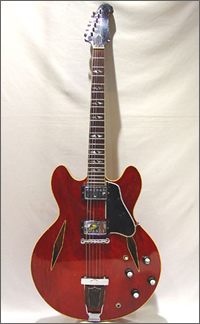 The Standard is based on the classic ES335 shape, but with a trapeze tailpiece (as seen on early Gibson Les Pauls) and diamond-shaped soundholes. The guitar also differed to an ES335 in that it had a Gibson Firebird neck set into the body.
The Standard is based on the classic ES335 shape, but with a trapeze tailpiece (as seen on early Gibson Les Pauls) and diamond-shaped soundholes. The guitar also differed to an ES335 in that it had a Gibson Firebird neck set into the body.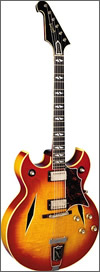 The Lopez models were discontinued in 1971 and are collectible and highly prized today, although not particularly expensive at this point in time.
The Lopez models were discontinued in 1971 and are collectible and highly prized today, although not particularly expensive at this point in time.
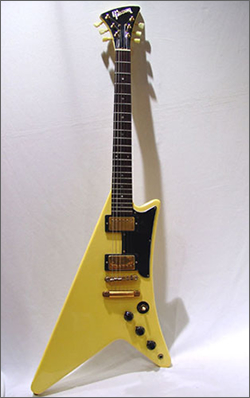 The Gibson Moderne is one of Gibson’s most infamous instruments, and due to its limited production and the story surrounding it, it has acquired semi-mythical status.
The Gibson Moderne is one of Gibson’s most infamous instruments, and due to its limited production and the story surrounding it, it has acquired semi-mythical status.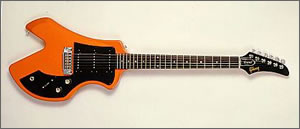 The Corvus (Latin-speakers may know this is a Latin word meaning crow, which is maybe what Gibson were trying to emulate with this shockingly unconventional design) was a complete failure for the company and was withdrawn, having sold barely any units, in 1984.
The Corvus (Latin-speakers may know this is a Latin word meaning crow, which is maybe what Gibson were trying to emulate with this shockingly unconventional design) was a complete failure for the company and was withdrawn, having sold barely any units, in 1984.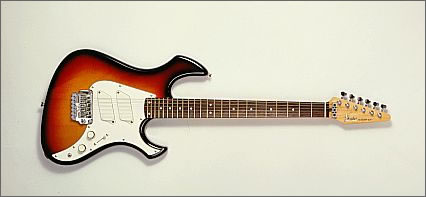 The unusual body and headstock shapes have been rumored to have originated in the shape of the scrap wood leftover from making Japanese Stratocasters. The body is small with a deep double cutaway. The tuning machines are found on the upper edge of the triangular headstock. The fretboard is two octaves and features a locking nut and jumbo frets. The bridge is a floating System I tremolo. Both bass and guitar are built to the highest level of quality and detailing. For example, the controls have inset rubber grips, the tuning heads have fully enclosed gears and the jack sockets are an enclosed, not ‘skeleton’, type, in contrast to many other Fender products with more ‘economy’ hardware.
The unusual body and headstock shapes have been rumored to have originated in the shape of the scrap wood leftover from making Japanese Stratocasters. The body is small with a deep double cutaway. The tuning machines are found on the upper edge of the triangular headstock. The fretboard is two octaves and features a locking nut and jumbo frets. The bridge is a floating System I tremolo. Both bass and guitar are built to the highest level of quality and detailing. For example, the controls have inset rubber grips, the tuning heads have fully enclosed gears and the jack sockets are an enclosed, not ‘skeleton’, type, in contrast to many other Fender products with more ‘economy’ hardware.
 The Bond Electraglide was a very unusual, little-known guitar made in Scotland by Andrew Bond in 1984-5.
The Bond Electraglide was a very unusual, little-known guitar made in Scotland by Andrew Bond in 1984-5.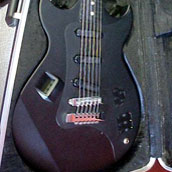 The guitar was launched at the 1984 NAMM show in America. Apart from the various gimmicks featured on the guitar, including the required use of an external power supply, it played normally and sounded normal, with three single-coil pickups and a normal body shape.
The guitar was launched at the 1984 NAMM show in America. Apart from the various gimmicks featured on the guitar, including the required use of an external power supply, it played normally and sounded normal, with three single-coil pickups and a normal body shape.
 The Katana and Performer were exclusively built in Fender’s then – new Japanese plant, built in response to much cheaper and nearly as good Japanese copies of Fender’s models.
The Katana and Performer were exclusively built in Fender’s then – new Japanese plant, built in response to much cheaper and nearly as good Japanese copies of Fender’s models. You can read more about the superstrat in our
You can read more about the superstrat in our 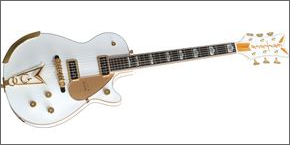 The 6136 (also known as the White Falcon or “the Cadillac of guitarsâ€) is a well-known Gretsch guitar, a big-bodied semi-acoustic finished in gleaming white, with all manner of elaborate trimmings like an armrest on the bass side of the body, gold binding and a huge tone that saw it used by Brian Setzer, Billy Duffy of The Cult and Stephen Stills.
The 6136 (also known as the White Falcon or “the Cadillac of guitarsâ€) is a well-known Gretsch guitar, a big-bodied semi-acoustic finished in gleaming white, with all manner of elaborate trimmings like an armrest on the bass side of the body, gold binding and a huge tone that saw it used by Brian Setzer, Billy Duffy of The Cult and Stephen Stills.